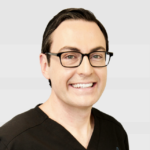Rhinoplasty is the surgical modification of the shape of the nose, also known as “nose job surgery” or nose reshaping. This procedure can be performed via two approaches. The first is called “open” or external rhinoplasty and uses an external incision. The second is called “closed” or endonasal (inside of the nose) and has only hidden incisions. The choice of approach is dictated by the specific goals of the patient, any functional issues (i.e., breathing problems), and/or cosmetic issues which require a specific technique. In addition, most revision rhinoplasty surgery requires an open approach due to the complex and sometimes unpredictable nature of this procedure and the need to provide internal support during the healing process.
Open rhinoplasty involves a small incision placed in the columella (the skin at the bottom of the nose between the two nostrils). This incision allows wide exposure and assessment of the nasal cartilages and bones and is closed with tiny sutures without tension so as to promote healing. A better view of the nasal structure facilitates more precise treatment of the underlying issues with the shape of the nose, as well as a more accurate diagnosis of any functional issues. In cases where the patient wants to significantly change the size and shape of the tip of the nose, an open approach is essential – this allows Dr. Ransom to trim the cartilage, improve the symmetry of the two sides of the nose, and create a more pleasing shape for the whole tip. Some examples of common problems that can be addressed via an open approach include a “bulbous” or “boxy” tip, asymmetry tip cartilages, a crooked or deviated nose, and a nose that is too long (over-projected or “tension nose”) or “droopy” (“hook nose”, hanging columella or excessive nostril show).
Closed rhinoplasty eliminates the incision in the columella and places the remaining incisions between the nasal cartilages inside the nose. This technique is very useful for patients with concerns about a “bump” on the bridge of the nose (nasal dorsum) but who desire minimal or no change to the nasal tip. Recovery from closed rhinoplasty is generally very quick. In most patients, the majority of the swelling in the nose lasts for about a week. In addition, Dr. Ransom does not use any nasal packing, which allows the patient to breathe normally after the surgery and significantly reduces postoperative discomfort. Typically, patients will have a flexible plastic cast on the nose for about a week. All the sutures in closed rhinoplasty are dissolvable, so no suture removal appointments are needed. Septoplasty can be performed along with either an open or a closed rhinoplasty and can help to straighten a crooked nose and improve the patient’s breathing or reduce snoring.
There are a lot of opinions out there about which approach to rhinoplasty is better. The truth, however, is that the best approach is a patient-specific approach – your surgery should be planned and performed in the way that gives you the best result. Dr. Ransom is experienced with both open and closed rhinoplasty, and he can perform your surgery either way. During your consultation and pre-operative appointment, a plan that works for your nose will be discussed in detail and agreed upon. Different noses work for different faces, and Dr. Ransom is sensitive to patients’ desires to “look like me” after the procedure. Dr. Ransom works with each individual patient to create the nose that they have always wanted.
Frequently Asked Questions
With closed rhinoplasty, the swelling of the nose is typically somewhat less and may resolve more quickly. This is especially true in the tip region. In addition, since there are no external sutures, you are not required to come back for a suture removal visit during the first few days. Bruising is similar and is largely dependent on whether the nose bones were altered or straightened during the procedure. Regardless of approach, you will have a cast on the nose for about a week after the surgery. This helps to protect the nose from accidental trauma and also stabilizes the bones during the initial healing phase. You will likely feel tired for a couple of days and should limit your activities and concentrate on resting and recovery.
Dr. Evan Ransom is an Ivy League-educated and Ivy League trained Facial Plastic and Reconstructive Surgeon. He is a Double Board Certified Head and Neck Surgeon and Facial Plastic and Reconstructive Surgery and fellowship-trained in facial plastic, reconstructive, and laser surgery. His practice is in the San Francisco Bay Area, serving patients from San Francisco, Oakland, Marin County, Palo Alto, Silicon Valley, Walnut Creek, the East Bay, and all over Northern California.
 (415) 550-1077
(415) 550-1077 San Francisco
San Francisco

